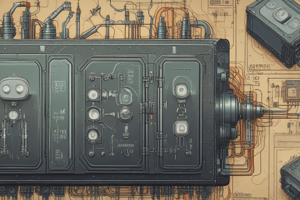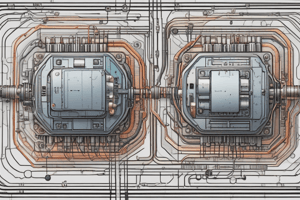Podcast
Questions and Answers
What is a relay primarily used for?
What is a relay primarily used for?
- To store electric current for later use.
- To convert magnetic fields into electric currents.
- To amplify small electric currents to larger levels. (correct)
- To create resistance in an electrical circuit.
Which component in a relay acts like a mechanical switch?
Which component in a relay acts like a mechanical switch?
- The switch lever.
- The contacts. (correct)
- The electromagnet.
- The power source.
What occurs when the current stops flowing through a relay's electromagnet?
What occurs when the current stops flowing through a relay's electromagnet?
- The contacts remain connected.
- The contact returns to its original position. (correct)
- A new circuit is activated.
- The electromagnet becomes permanently magnetized.
What is the role of the electromagnet in a relay?
What is the role of the electromagnet in a relay?
What type of current does a relay typically control?
What type of current does a relay typically control?
Why are relays particularly useful with sensors?
Why are relays particularly useful with sensors?
How does a relay convert a small current into a larger one?
How does a relay convert a small current into a larger one?
What would happen if a small electric motor were directly connected to a large electric current without a relay?
What would happen if a small electric motor were directly connected to a large electric current without a relay?
Flashcards
What is a Relay?
What is a Relay?
An electromagnetic switch controlled by a small current that can switch on or off a larger current.
What is an electromagnet?
What is an electromagnet?
A coil of wire that becomes magnetic when electricity flows through it. It's the core component of a relay.
How does a relay work?
How does a relay work?
A relay uses an electromagnet to physically connect or disconnect two contacts, allowing or stopping the flow of electricity in a larger circuit.
Why are relays needed?
Why are relays needed?
Signup and view all the flashcards
What are the two main functions of a relay?
What are the two main functions of a relay?
Signup and view all the flashcards
What are the main parts of a relay?
What are the main parts of a relay?
Signup and view all the flashcards
How does the electromagnet work in a relay?
How does the electromagnet work in a relay?
Signup and view all the flashcards
What happens when the electromagnet is de-energized?
What happens when the electromagnet is de-energized?
Signup and view all the flashcards
Study Notes
Relays
- Relays are electromagnetic switches that use a small electrical current to control a larger one.
- The core component is an electromagnet, a coil of wire that becomes a temporary magnet when electricity flows through it.
- Relays act as an electric lever, switching on a larger appliance with a smaller current.
- They are crucial for controlling sensitive electronic equipment with small currents, enabling control of larger appliances with higher currents.
- Relays can function as both switches (turning things on/off) and amplifiers (converting small currents to larger ones).
Relay Operation
- Relays have two main parts: contacts and an electromagnet.
- Contacts function like mechanical switches, connecting or disconnecting electrical circuits.
- The electromagnet, powered by a different circuit, is responsible for triggering the contacts.
- When current flows through the electromagnet's coil, a magnetic force is created pulling a contact to another, creating a closed electrical circuit.
- When the current stops, the magnetism disappears, and the contact is restored to its original position.
Relay Necessity
- Small motors use minimal electricity, thus, small wiring and switches are sufficient.
- Large motors require larger currents and consequently, larger wires and switches.
- Relays overcome a crucial limitation: using smaller switches and thinner wires for large applications which are cumbersome and inefficient otherwise.
- Relays allow controls to be smaller and simpler and cabling between control boxes and motors more manageable
Studying That Suits You
Use AI to generate personalized quizzes and flashcards to suit your learning preferences.



